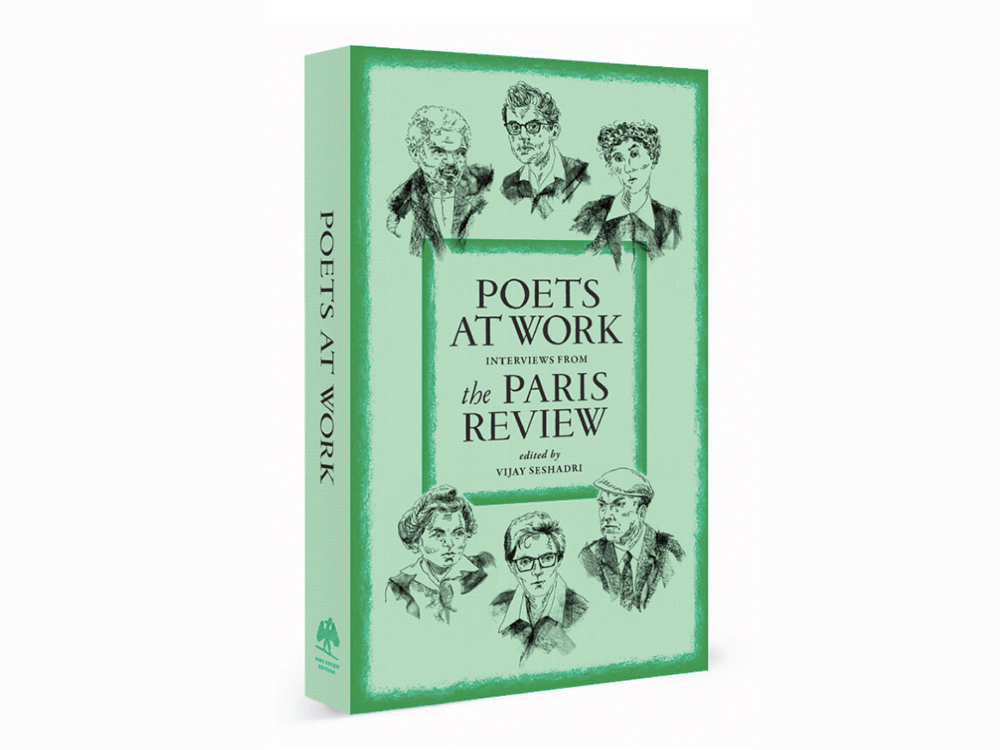Published earlier this week, Poets at Work is the latest from Paris Review Editions, the book imprint of The Paris Review. The anthology gathers thirteen Art of Poetry interviews from the magazine’s nearly seven decades of history. In the book’s preface, which appears below, The Paris Review’s poetry editor, Vijay Seshadri, explains the process by which he selected this baker’s dozen, as well as the particular pleasures of the magazine’s Writers at Work interview series.
The Paris Review’s first Art of Poetry interview was with T. S. Eliot, and was published in issue no. 21, Spring–Summer 1959. As the magazine had been publishing interviews since its inception, in 1953, transforming in the process a commonplace American journalistic feature into something like an art form, it isn’t unreasonable to ask why it took so long to get around to a poet. (Robert Penn Warren had been interviewed, but about his fiction, and an early attempt to corral Robert Frost had failed.) Poets sensitive about the prerogatives of their art should be reassured, though, just by the nature of the Paris Review interview itself—a natural-seeming object that is actually delicate and labor intensive and involves the intersection of many serendipitous elements, not the least of which is the rare sympathy between interviewer and subject that brings a conversation to life. Also, along with the usual chances and mischances of publishing, when it came to a magazine that saw itself as canonical (in an era when there was such a thing as the canonical) and at the same time improvisational, secular, hip, casual, and cosmopolitan, editorial choices must have been made under multiplying, contradictory pressures.
Whatever the reasons, once the interviews of poets got going, they sprinted along, energized perhaps by the editors’ coming to recognize that poets are very good at talking about themselves. The resulting hundred-plus conversations from which this selection was made are rich and various, and so satisfying across the board that choosing just a baker’s dozen was an excruciating job. Even limiting the set to poets born before the historical watershed of World War II left over sixty to choose from—interviews with fathers of civilizations (Frost, William Carlos Williams, Eliot, W. H. Auden), poets unfairly neglected or forgotten (Conrad Aiken, Charles Tomlinson, May Sarton, Amy Clampitt, John Hall Wheelock, Karl Shapiro), masters outside the anglophone tradition (George Seferis, Yevgeny Yevtushenko), and several of the most celebrated poets of the Silent Generation (Seamus Heaney, Gary Snyder, Charles Wright).
None of the poets inside the parentheses above are included in this anthology. Given their stature, and that of others who aren’t included, it’s probably important to clarify if possible why the thirteen here and not others. Some of these choices derive from the information, the news, in the interviews. Some derive from an acknowledgment of history and a recognition of its complicated, sometimes tragic relationship with literature. Some take advantage of the small license anthologists have to reflect their own experience. Ezra Pound was the poet I chose first—for his central importance to the poetry of his time and ours, for the large historical stage he sought, and also for the compelling, sometimes maddening quality of the interview. Pound seemed to be entangled historically with Yehuda Amichai—whose work I happen to love, and whose interview is as compelling as Pound’s. Apart from his importance to poetry, the tremendous romance of Pablo Neruda’s life seemed to make his presence necessary. Nothing could ever keep me from putting Elizabeth Bishop in an anthology, given the opportunity. It seemed to make sense, then, to also include Robert Lowell and Marianne Moore, because apart from their grandeur as poets and the value of their conversations, Bishop’s life as a writer was tangled up with theirs. (I kept going back and forth between Moore and Anne Sexton, opposites as poets and people; I would have liked to include both for the contrast alone.) Allen Ginsberg and John Ashbery have been major facts of the literary landscape of the past fifty years, and were major facts for me in my early years as a poet. I met Ishmael Reed, a grand literary presence in the Bay Area of the seventies, when I was twenty years old.
If these reasons are more psychological than logical, that seems unavoidable to me. A hundred educated readers confronting the problem of making this anthology would come up with a hundred different solutions. It hardly seems to matter. Even the most perverse-seeming selection wouldn’t be egregious. The intersections and interweavings, the similarities and intriguing contrasts among these poets and among their conversations are endless.
Almost as important as purely literary considerations was a broad interest in the ways these poets played with and against the genre of the Paris Review interview itself—a format as much dramatic and musical as journalistic, with its mise-en-scène, its careful give-and-take, its back-and-forth, its rhythmic movements and countermovements, its subtle editorial shaping. Goethe said that the string quartet is like a rational conversation among four people. A Paris Review interview, a rational conversation on its surface, is like a violin sonata with keyboard accompaniment by the interviewer, or a cabaret act with a singer backed up by a piano. Sometimes, as in Wallace Shawn’s interview with Mark Strand, it turns into a full-blown violin/viola duo. People interested in learning about the poets here will find literary history, literary insight, gossip, humor, perspective, universal and particular knowledge. People who already know the poets, and know the way their poems and lives intersect, will experience, along with the pleasure of revisiting their knowledge, a continuous musical delight.
Vijay Seshadri is the poetry editor of The Paris Review.
Poets at Work is on sale now.
from The Paris Review https://ift.tt/3sL0yvH

Comments
Post a Comment